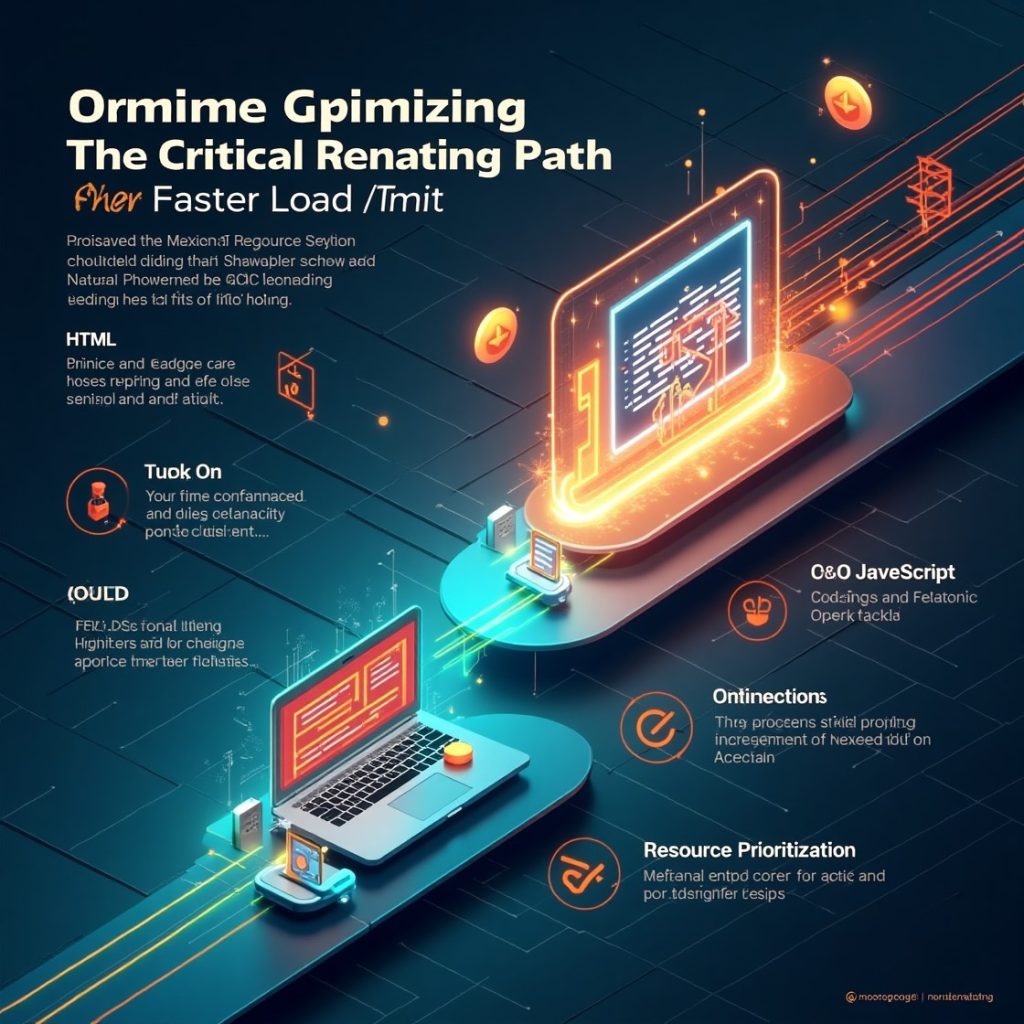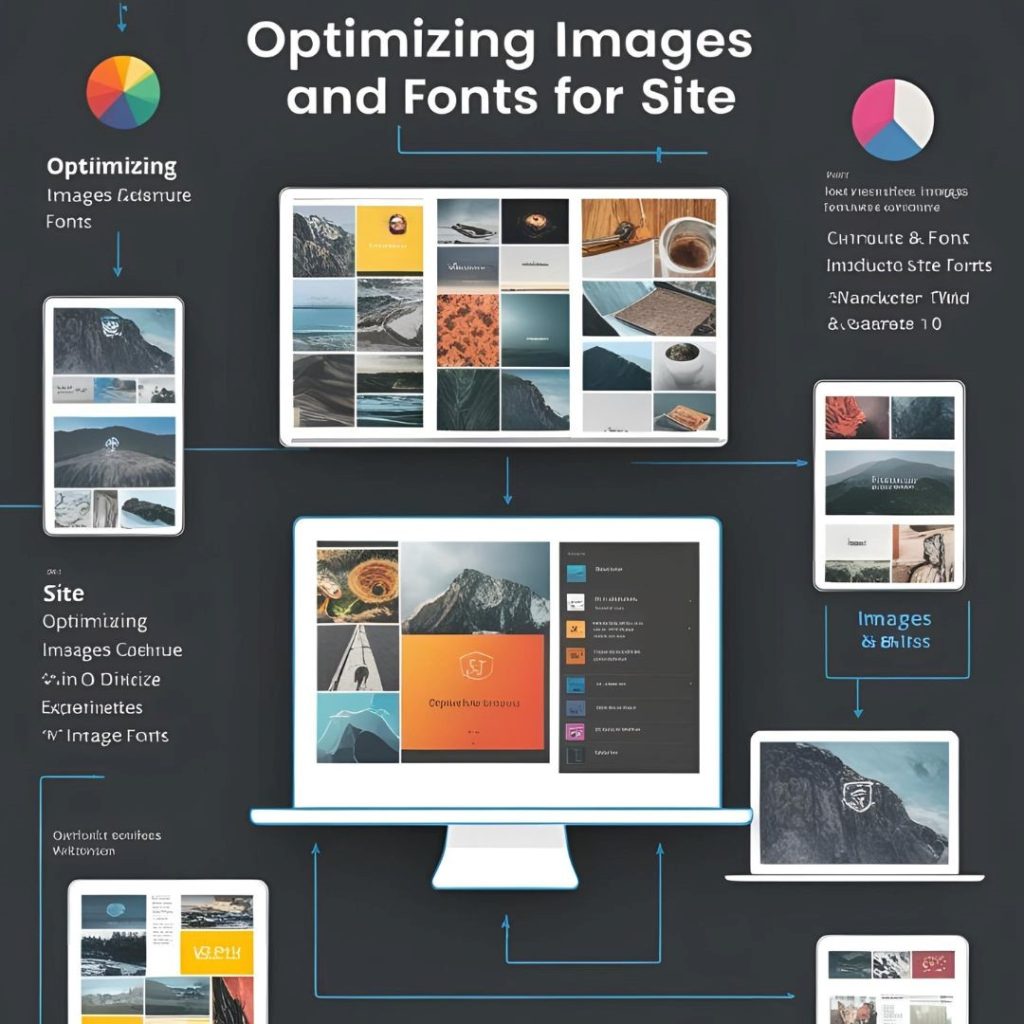Introduction
Modern web surfers now require very fast pages to load. It’s a real pity that if your website takes longer than a couple of seconds to load, the visitors will probably leave prior to seeing any content. The concept of the Critical Rendering Path (CRP) forms the vital part of the process of fast page loading. The level of our website’s performance can be increased if we understand the path and execute the related optimization. In this piece, we will go over the details of what is the CRP, its importance, and each stage of the optimization process.
What is the Critical Rendering Path?
The Critical picture Path is the sequence of way a cyber-surfer goes through to convert your HTML, CSS, and JavaScript into pixels on a screen. It’s a complex process that starts from downloading your webpage’s coffers and ends with rendering them visually. When a stoner requests a web runner, the cyber surfer begins by downloading the HTML. As it parses the HTML, it encounters CSS and JavaScript lines. These lines must also be downloaded and reused before the cyber surfer can render the runner. This chain of conduct is the CRP.
Understanding the CRP is pivotal because any detainments in this process will delay the point at which your runner becomes visually usable. However, also optimizing this path should be a precedence, if you are aiming for better stoner experience and advanced engagement. A well- optimized CRP helps your runners render briskly, reducing cargo times and perfecting perceived performance. It also plays a significant part in hunt machine optimization, especially with Google’s Core Web Vitals now being a ranking factor. To truly optimize your point for speed, you must understand each element of the CRP and how to streamline it.

Components of the Critical Rendering Path
To optimize the Critical picture Path, it’s essential to first understand its crucial factors
1- Document Object Model( DOM)
2- CSS Object Model( CSSOM)
3- Render Tree
4- Layout
5- oil
Each part plays a part in getting your content from law to visual affair. Let’s take a brief look at each before diving into heads for farther disquisition. The DOM is created when the cyber surfer parses HTML. The CSSOM comes from parsing CSS lines. The Render Tree combines both, determining what gets displayed. Layout involves calculating element positions on the runner. Eventually, oil puts pixels on the screen.
Document Object Model (DOM)
The DOM is a tree- suchlike structure that represents the HTML of your runner. As the cyber surfer reads the HTML, it constructs the DOM by converting each HTML element into a knot in the tree. Effective DOM construction is pivotal for performance. The larger and more complex you’re HTML, the longer it takes to make the DOM. Simplifying your HTML structure and avoiding deeply nested rudiments can help reduce this time. JavaScript can also manipulate the DOM, which can add complexity. While this can produce dynamic gests, inordinate DOM manipulation can decelerate down picture. To optimize the DOM, minimize gratuitous HTML, use semantic markers, and streamline JavaScript relations. Understanding the DOM and keeping it clean lays a solid foundation for the rest of the picture path.
CSS Object Model (CSSOM)
The CSSOM is created when the cyber surfer parses your CSS lines. It’s a tree that represents the styles and their connections. Together with the DOM, it forms the base of the Render Tree. A vital point to note is that the cyber surfer blocks rendering until both the DOM and CSSOM are ready. This is why CSS is considered render- blocking by dereliction. To optimize CSSOM creation, avoid including gratuitous CSS rules, and consider decoupling your styles into critical and on-critical CSS. Inclining critical CSS directly into your HTML can speed up the original render. Tools like Critical can help automate this process. Also, avoid large external style sheets that delay parsing. Optimizing CSSOM creation ensures your point styles are applied snappily, helping render content sooner.
Render Tree
The Render Tree is the result of combining the DOM and CSSOM. It determines what content will actually be displayed on the screen and how it should look. Not everything in the DOM is rendered for case, scripts or rudiments with display none are barred. The Render Tree focuses only on visual rudiments. Once constructed, it helps the cyber surfer calculate the layout of each element. To optimize the Render Tree, concentrate on barring unused CSS, reducing style recalculations, and avoiding layout thrashing (frequent DOM read/ write cycles). Using simpler CSS pickers can also ameliorate performance then. A clean and terse Render Tree pets up the picture channel and contributes to faster cargo times.
Layout
Once the Render Tree is ready, the cyber surfer performs a layout (also known as flow). This step involves determining the position and size of every visible element. Layout performance can suffer if your styles involve complex computations or if you are constantly reading and writing DOM values via JavaScript. Avoid using JavaScript robustness that alter layout parcels similar as range, height, or top, as these can spark precious layout recalculations. Rather, use CSS robustness and transitions where possible, especially those that affect transfigure and nebulosity, which don’t bear layout recalculations. Optimizing layout helps maintain a smooth picture process, especially important for responsive and interactive designs.
Painting
The final step is oil, where the cyber surfer takes the advised layout and styles and converts them into pixels on the screen. This step can also include compositing, where layers are combined together. Oil performance depends on the complexity of your illustrations. Avoid heavy murk, slants, or large repaints caused by frequent style changes. Using will- change on rudiments you plan to amp can give the cyber surfer a hint to prepare rendering in advance. But stereotyping it can boomerang and consume further memory. Keeping your illustrations simple and your robustness effective leads to quicker and smoother oil.
Optimization Strategies for the Critical Rendering Path

Now that we’ve covered the factors of the CRP, let’s look at concrete optimization strategies that target each stage of the process. From reducing render- blocking coffers to using ultramodern tools, these ways can significantly reduce cargo times and ameliorate stoner experience.
Minimize Critical Resources
Critical Coffers are those that must be loaded and reused before the runner can be rendered. Reducing the number and size of these coffers helps dock the CRP. Launch by relating what’s truly demanded for the first render. Use tools like Chrome Dev. Tools or Lighthouse to spot render- blocking coffers. Also, detention lading of non-critical CSS and JavaScript. You can achieve this using sync and postpone attributes on script markers. CSS can be resolve into critical (inclined) and non-critical (loaded latterly). Every bite you save reduces the time the cyber surfer spends downloading and parsing content. Be purposeful about what gets loaded first, and your point will feel important faster.
Defer and Sync JavaScript
JavaScript can block the picture process if not managed duly. Scripts loaded synchronously will halt HTML parsing until they finish executing, delaying runner picture. Using postpone tells the cyber surfer to download the script in resembling with HTML parsing but only execute it after the document has been parsed. Sync, on the other hand, downloads and executes the script as soon as it’s available, which can be changeable. For scripts that affect the UI, postpone is generally the safer choice. For analytics or advertisements, sync can be useful. Managing script lading strategically allows the cyber surfer to concentrate on getting your content on the screen briskly.
Inline Critical CSS
Inclining critical CSS involves bedding the styles needed for the first visible portion of the runner directly within the HTML. This eliminates the need to cost external style sheets before rendering. This fashion significantly improves the First Contently Paint (FCP) — the time it takes for the stoner to see any visual response. After inclining, the rest of your CSS can be loaded asynchronously. Numerous make tools like web pack, Parcel, or specialized tools like Critical or extension can help automate this process. Inline wisely, as too important inline CSS can bloat your HTML. Focus on the styles demanded above the pack.
Optimize Fonts and Images
Sources and images are frequently large and render- blocking if not optimized. Sources should be loaded with fountain- display exchange to avoid unnoticeable textbook during cargo. Use ultramodern formats like WOFF2 for sources and Web or AVIF for images. Compress images using tools like Tiny PNG or Squash. Lazy lading images that are not incontinently visible can also significantly reduce original cargo times. Every kilobyte matters optimized media reduces bandwidth operation and pets up the picture path.
Use a Content Delivery Network (CDN)
A CDN distributes your content across multiple geographically dispersed waiters. When a stoner visits your point, they admit content from the closest garcon, which reduces quiescence and cargo time. Using a CDN for your scripts, styles, sources, and images ensures briskly delivery. Some CDNs indeed offer erected- in optimization features like image contraction or automatic cache nullification. It’s one of the easiest ways to ameliorate performance without changing your point’s law.
Conclusion
Tuning the Critical Rendering Path isn’t merely a technical adjustment — it’s a user-centered strategy. Smaller load times equal faster user experience, fewer bounce rates, and increased engagement. By recognizing and tuning every phase of the CRP — from parsing HTML to painting pixels — you’re positioning your site for success.
Seconds count when it comes to web performance. With careful optimization, your site can deliver speed, responsiveness, and reliability today’s users expect.
Start small: inline critical CSS, defer non-critical scripts, and reduce what your browser must execute. Over time, these steps will yield huge dividends in performance.